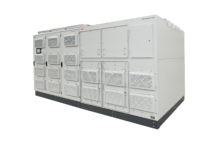Uninterruptible Power Supplies director Alan Luscombe discusses how to implement a UPS as a network-visible device, and considers the benefits of doing so…
 Data centre operators are willing to invest in UPS systems because they protect the facility’s critical load from noise, spikes, brownouts and other mains-borne aberrations, and from complete power blackouts.
Data centre operators are willing to invest in UPS systems because they protect the facility’s critical load from noise, spikes, brownouts and other mains-borne aberrations, and from complete power blackouts.
The UPS’s success depends heavily on having enough battery autonomy to ride through brief power failures, or to allow a generator to come on line if this autonomy becomes likely to be exceeded. If no generator is available, the UPS should give the critical load enough warning to shut down safely before the batteries are finally exhausted.
The above scenarios highlight the need for efficient, reliable communication between the UPS, generator if present, and the critical load. Without this, the generator won’t receive the timely warning it needs to start up, nor will the load be alerted to shut down safely before the power fails; the battery autonomy becomes pointless. Additionally, the UPS should be able to communicate its status and flag any issues to appropriate maintenance resources that can take pre-emptive action. Finally, the UPS should be amenable to remote command and control, allowing deployment into widely distributed or unattended locations.
Simple communications
Modern UPS systems contain facilities to communicate with operator stations, building management systems and other facility networks, as well as the critical load and generators. Even those that do not have full network capability have at least a simple set of volt-free contacts that supply status information as a set of true/not true signals.
These contacts typically signal mains supply status, battery condition or an alarm indication. Software within most Windows, Mac, Linux and other operating systems can use these signals to initiate an orderly system shutdown or perform other actions as required. It is usually available from the UPS or network operating system supplier.
A more sophisticated approach uses serial RS-232 or USB communications to exchange more information. This can include analogue values for inverter and bypass output voltage, frequency, current, kVA and kW, battery conditions and statistics for mains failures and UPS operation. Software is also available to handle alarm monitoring and emergency shutdown procedures.
In addition to displaying this information graphically and periodically logging it, the software usually allows operators to configure appropriate responses to alarms, and schedule diagnostics checks.
Networking and SNMP
Many operators today want to see their UPS systems integrated into their facility networks as network attached devices, just like the rapidly growing number of other attached Internet of Things (IoT) items. This allows higher volumes of data to be moved in real time between large numbers of UPSs and other equipment, even if they are distributed across a large site or even around the world.
To achieve this, some issues must be overcome. If a large number of ‘talkative’ items are widely distributed, some will find themselves on sites without human operators ready to handle any problems as they arise. This could lead to irreparable damage to system hardware and software.
Fortunately, a solution is available in the form of simple network management protocol (SNMP); this allows a centrally located network manager to monitor and control UPSs and other network devices across the entire network.
SNMP is a part of the transmission control protocol/internet protocol (TCP/IP) suite which, by operating as a single standard, allows all network devices to transmit management variables across enterprise-wide networks. Accordingly, a modern UPS should come with SNMP compatibility to support connection to major network management systems such as IBM’s Tivoli NetView or HP OpenView. A UPS can become a SNMP-enabled device with the addition of an adaptor card or box that can interface between the UPS’s serial port, or even volt-free contacts, and the enterprise network.
SNMP is vendor and platform independent and establishes guidelines for what information will be collected, how it will be structured and how the messages are mutually formatted between the network device and the manager. Network devices then gather information into a management information base (MIB). Users’ operating systems can use SNMP software to collect and display MIB data in an easily understood format.
An SNMP-enabled UPS is an intelligent device that can log activity and alarm events, continuously monitor power quality, report on battery status, load and temperature, and perform self-diagnostics. It should also support remote control, graceful shutdown and rebooting of multiple UPS-protected devices over the network or internet, and provide alarm notification through email, mobile phone or SMS texts.
Examples and benefits of UPS networking
UPSL’s PowerREPORTER is one practical example of a networking UPS as part of a protection and maintenance strategy. The software continuously monitors the UPS to detect any error or alarm messages; if an incident occurs, it communicates with UPSL’s service centre, providing a device identification string together with any available details on the device’s status and fault condition.
This information allows UPSL’s field staff to liaise with the UPS site operators, perform remote diagnostics and arrive on site within agreed timescales and with the right test equipment and spares holding. This not only allows timely responses to failures, but also facilitates early fault detection and pre-emptive action to assure continuous availability – the ultimate goal of any data centre manager.
Batteries are always a potential vulnerability for any UPS installation unless they are carefully maintained, operated and monitored. A network-enabled UPS can benefit from using PowerNSURE, a remote battery monitoring and management system that checks the internal resistance, temperature and voltage of every UPS battery sequentially.
By continuously monitoring each battery block’s individual charging voltage, it ensures equalisation – a regime of optimal charging levels which avoids problems of gassing, dryout and thermal runaway arising from overcharging. It also prevents undercharging-related problems such as sulphation and loss of capacity.
By protecting the batteries through equalisation, their service life can be extended by up to 30%. However, if rises in temperature and internal impedance do occur, remote detection of these can indicate problems and allow corrective action before they lead to failure. Figure 1 shows how displays generated by the software give a visual indication of a weak battery that needs rapid attention before failure.

Generator reliability is as vital as UPS reliability to ensure power protection in the event of an extended blackout. Availability can be improved through using a remote monitoring system that automatically starts each generator once a week and runs it for 10 minutes, checking voltage, frequency, oil and water temperature, battery condition, emergency stop and fuel levels.
A condition report based on these measurements is sent to the monitoring centre, with SMS or voicemail messages also sent to nominated mobile phone numbers. Monitoring can be performed on a 24/365 basis. Notification of mains failure and generator operation can be provided, together with successful test run confirmation and automatic low fuel warnings.
Networking and internet technology allow a UPS to be added to the edge of the enterprise network like other IoT devices, and made visible and controllable accordingly.



